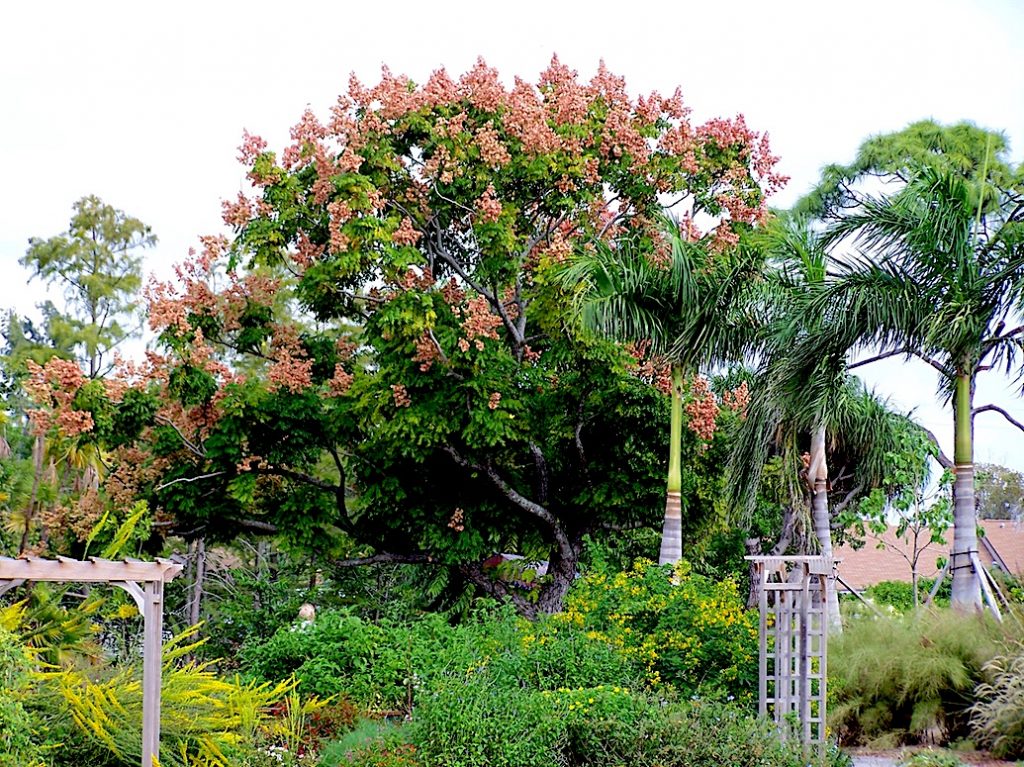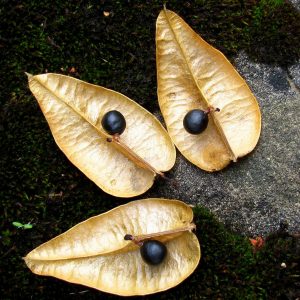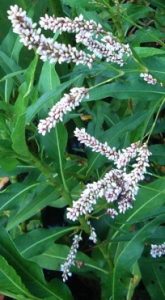
Golden Rain Tree. Photo by Mounts Botanical Garden, Palm Beach County.

Golden Rain Tree seeds. I wonder if they are more edible when young and green?
The tree is easy to find but is it edible? The answer is yes, maybe, barely. It depends on which part you’re referring to. The problem is the more edible parts are around when you don’t notice the tree — spring time — and the least edible parts are around when you do notice it. Thus I never quite get around to knowing all that the Golden Rain tree has to offer. In the spring it has tender young shoots and leaves. They are edible after cooking. Don’t try them raw, they have a bit of cyanide in them. Months later in the fall the seeds are reported as a famine food, not exactly a glowing endorsement. In between the yellow flowers are used for a dye as is the bark. Those boiled leaves and shoots do have some antioxidant and anti-tumor capacity but the research is slow making it way out of arcane journals to common knolwedge. As for the seeds… they are kind of in the same position as the particular mustard seed which is used to make Canola Oil. They are edible but like unrefined Canola Oil they can be irritating. What I might try to do is collect some seeds, sprout them, boil them, and give them a try… but let me do that first instead of you. You can read about the Golden Rain Tree here.

24-hour watch (which are hard to get repaired)
I spend a lot of time in the woods, and also afloat. Three things you should always know in such environments are the cardinal directions, time of day, and the weather. I happened to have gotten the gene for divining time, distance and direction. I can guess the time within 15 minutes, usually less, and estimate large distances to within a mile or so. I usually know which way is north, east, south and west. I’m definitely a vector person, well-grounded in time and space, and always carry a time piece. With that — digital or other wise — I always know for certain the time of day and which way is north. ( Also keep an eye on the clouds. On a 24-hour basis you can be as accurate as the weather bureau just by watching the clouds.) You can tell the compass directions with any watch but I like my 24-hour wrist watch. I point the hour hand towards the sun and 12 o’clock is south, 24 o’clock is north, 6 east, 18 west. It is the opposite in the southern hemisphere. Simple, unless it’s daylight savings time, which I don’t go on and rant about here.

Dog Park, Jervey Gant Complex, Ocala. Photo by Green Deane
It’s a topic that concerns foragers: The fact that animals use the outdoors as their bathroom. There are some reasons for concern and some reasons not to be too concerned. I noticed some 60 years ago that wherever our dog Sister piddled on the lawn — what we had of it — the grass died. (She was called Sister because I didn’t have a sister, or a brother for that matter.) The reason given for the grass death is a high urea content which is essentially nitrogen overload. As a fertilizer a little dog piddle goes a long ways. Since we tend to not eat dead grass or the like it really isn’t a problem. Inside the home it’s the ammonia component that can irritate lungs and offend the nose. But outside most urine degrade fairly quickly and is not known for carrying a lot of long-lived bacteria. This is not so with other off-loaded material. Pets can be a source of varying diseases, bacterial to parasitical. Cat scat is among the most common domestically. Your feline’s deposits in your backyard can cause problems particularly to young children who are pretty close to the ground and what in it. Ditto dogs. And to be more specific it is the scat of primarily meat eaters that is more of a problem that other animals. Indeed, horse, cow and aged chicken manure was and in still in some places still the preferred fertilizers on many farms. Where I grew up slightly aged horse manure was favored for tomatoes. Cow manure was stronger and chicken manure was way to strong to use fresh. It would kill plants. Use some common sense: Don’t forage in a dog park.

Foraging classes are held rain, shine, hot or cold. Photo by Nermina Krenata
Upcoming foraging classes: Foraging classes this week range from the delightful Port Charlaotte to my own back yard on the time-change day (though as you can read above I don’t time change but others do.)
Saturday, November 3rd, Bayshore Live Oak Park, Bayshore Drive. Port Charlotte, 9 a.m. to noon. Meet at the parking lot of Ganyard Street and Bayshore Road.
Sunday, November 4th Blanchard Park, 10501 Jay Blanchard Trail, Orlando. 9 a.m. to noon. Don’t forget the clock turned back an hour last night.
Saturday, November 10th, Boulware Springs Park, 3420 SE 15th St., Gainesville, FL 32641. 9 a.m. to noon.
Sunday, November 11th, Dreher Park, 1200 Southern Blvd., West Palm Beach, 33405, West Palm Beach, FL 32641. 9 a.m. to noon. Meet just north of the science center.
You can learn more about the foraging classes here.

Smartweed
photo by Green Deane
Happily blossoming now — its fall flush — is Smartweed, a hot pepper substitute. What makes the plant “hot” I do not know and have never found quality research on that. However, it is super hot like many peppers, or shall I say it is perceived by us as “hot.” There are actually two sources of heat on the plant. The leaves have quite a bite and in some places are used as a pot herb. The blossoms are hot and bitter. The blossoms can be white or pink and the plant always grows in damp places if not in water. One odd thing about the species is that it can also be used to catch fish. To read about Smartweed go
 Donations to upgrade EatTheWeeds.com and fund a book have gone well and made it past the half way mark. Thank you to all who have contributed to either via the Go Fund Me link, the PayPal donation link or by writing to Green Deane POB 941793 Maitland FL, 32794. There are many needs left such as expanding the foraging teacher page and the page on monotypic edibles. Several functions were also lost when we transitioned to the new website. There’s always something and such things get more complex and expensive every year.
Donations to upgrade EatTheWeeds.com and fund a book have gone well and made it past the half way mark. Thank you to all who have contributed to either via the Go Fund Me link, the PayPal donation link or by writing to Green Deane POB 941793 Maitland FL, 32794. There are many needs left such as expanding the foraging teacher page and the page on monotypic edibles. Several functions were also lost when we transitioned to the new website. There’s always something and such things get more complex and expensive every year.

Green Deane DVD set of 135 videos
All of Green Deane’s videos are available for free on You Tube. They do have ads on them so every time you watch a Green Deane video I get a quarter of one cent. Four views, one cent. Not exactly a large money-maker but it helps pays for this newsletter. If you want to see the videos without ads and some in slightly better quality you can order the DVD set. It is nine DVDs with 15 videos on each for a total of 135 videos. Many people want their own copy of the videos or they have a slow service and its easier to order then to watch them on-line. The DVDs make a good gift for that forager you know especially on long, cold winter months. Individual DVDs can also be ordered or you can pick and choose. You can order them by clicking on the button on the top right hand side of this page (if your window is open wide enough.) Or you can go here.

Green Deane Forum
Want to identify a plant? Need to identify a plant? Looking for a foraging reference? Maybe you have a UFO, an Unidentified Flowering Object, you want identified. On the Green Deane Forum we — including Green Deane — chat about foraging all year. And it’s not just about warm-weather plants or just North American flora. Many nations share common weeds so there’s a lot to talk about. There’s also more than weeds. The reference section has information for foraging around the world. There are articles on food preservation, and forgotten skills from making bows to fermenting food. Recent topics include: I Finally Found Wapato, Looks like Corn, Weed With Pod At Top, A Mile Walk In The Woods, Chicken of the Woods?, Elderberry Fungus, Spurge Nettle 2018, Does Anybody Know This Berry, and Five-Minute “English” Muffin with Beautyberries. You can join the forum by clicking on the button in the menu line.
This is weekly issue 328.
If you would like to donate to Eat The Weeds please click here. Or you can use my Go Fund Me link, or by writing to Green Deane POB 941793 Maitland FL, 32794


In some north African Sahara countries use of stars during night and sun and shade during day is still not experienced by nomads and Bedwins . To mention an interesting point on urea we, as children , when wounded while playing in the woods , ask a fellow to urenate on the wound so as to cure .
Misuse may be use .